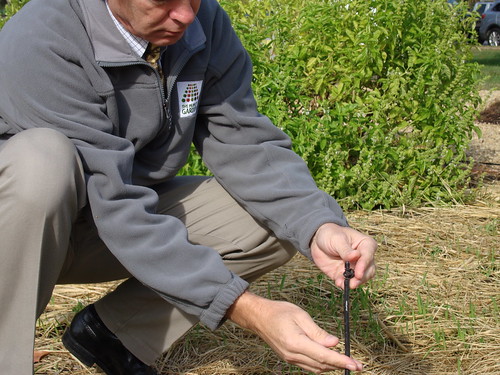
What do lawns, green roofs and electric bills have in common? If you ask Bob Snieckus, the answer is “energy.”
Even though Snieckus stays busy as National Landscape Architect for USDA’s Natural Resources Conservation Service (NRCS), he is also committed to conserving energy and improving sustainability in the Washington, D.C., buildings and landscapes where he works.
Snieckus’ usual work includes watershed projects, stream restorations and dam removals. However, as a member of the People’s Garden Team at USDA Headquarters, part of USDA's People’s Garden Initiative, he brainstorms ways to reduce the department’s energy consumption and water use on lawns and gardens.
“These efforts can be an important demonstration project to showcase energy and water conservation measures that our employees, our visitors and tourists can learn about and apply at home,” said Snieckus.
Snieckus helps develop energy reduction ideas for the landscapes around the building, such as increasing irrigation efficiency, installing drip systems and using solar-powered irrigation controllers. The ultimate goal is to harvest stormwater.
We want to reuse the stormwater that falls on USDA’s Washington, D.C., buildings and sidewalks by diverting it into cisterns, rain barrels and rain gardens. Rain barrels catch run-off from buildings, while rain gardens feature water-loving plants in landscaped depressions. Once harvested, the runoff is available for irrigation and other uses.

Snieckus also played a key role in designing a green roof that now covers part of the South Building. The roof showcases sculptural and colorful drought-tolerant plants that detain stormwater and are visible to hundreds of offices. The green roof also saves energy by reducing heating and cooling requirements for the offices below.
“It’s really satisfying to see the results of our work every day,” Snieckus says. “And I feel like what we do is an inspiration.”
Secretary Vilsack began the People’s Garden Initiative in 2009 in honor of President Lincoln’s founding of USDA as the “People’s Department” with a challenge to employees to create gardens at USDA facilities worldwide—starting with the Whitten Building. The Initiative has been spreading ever since – now with over 1,750 People’s Gardens located in all 50 states, three U.S. territories and twelve foreign countries. Search this interactive map to find a People’s Garden growing in a community near you. You can follow @PeoplesGarden on Twitter and visit us at usda.gov/peoplesgarden to learn more about greener gardening techniques.
